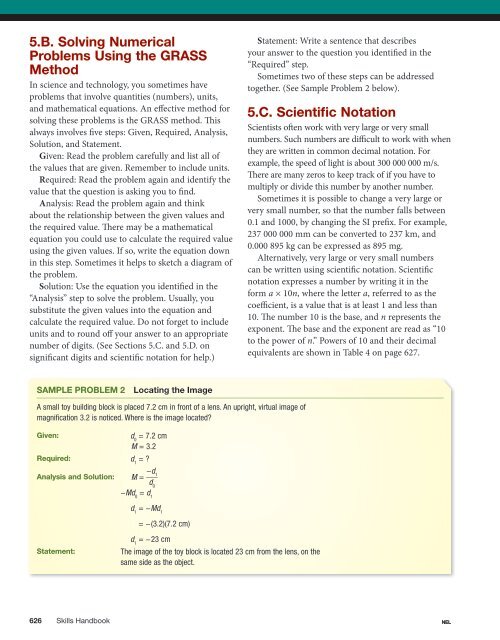PRE-PUBLICA TION EDITION - Nelson Education
PRE-PUBLICA TION EDITION - Nelson Education
PRE-PUBLICA TION EDITION - Nelson Education
You also want an ePaper? Increase the reach of your titles
YUMPU automatically turns print PDFs into web optimized ePapers that Google loves.
5.B. Solving NumericalProblems Using the GRASSMethodIn science and technology, you sometimes haveproblems that involve quantities (numbers), units,and mathematical equations. An effective method forsolving these problems is the GRASS method. Thisalways involves five steps: Given, Required, Analysis,Solution, and Statement.Given: Read the problem carefully and list all ofthe values that are given. Remember to include units.Required: Read the problem again and identify thevalue that the question is asking you to find.Analysis: Read the problem again and thinkabout the relationship between the given values andthe required value. There may be a mathematicalequation you could use to calculate the required valueusing the given values. If so, write the equation downin this step. Sometimes it helps to sketch a diagram ofthe problem.Solution: Use the equation you identified in the“Analysis” step to solve the problem. Usually, yousubstitute the given values into the equation andcalculate the required value. Do not forget to includeunits and to round off your answer to an appropriatenumber of digits. (See Sections 5.C. and 5.D. onsignificant digits and scientific notation for help.)Statement: Write a sentence that describesyour answer to the question you identified in the“Required” step.Sometimes two of these steps can be addressedtogether. (See Sample Problem 2 below).5.C. Scientific NotationScientists often work with very large or very smallnumbers. Such numbers are difficult to work with whenthey are written in common decimal notation. Forexample, the speed of light is about 300 000 000 m/s.There are many zeros to keep track of if you have tomultiply or divide this number by another number.Sometimes it is possible to change a very large orvery small number, so that the number falls between0.1 and 1000, by changing the SI prefix. For example,237 000 000 mm can be converted to 237 km, and0.000 895 kg can be expressed as 895 mg.Alternatively, very large or very small numberscan be written using scientific notation. Scientificnotation expresses a number by writing it in theform a × 10n, where the letter a, referred to as thecoefficient, is a value that is at least 1 and less than10. The number 10 is the base, and n represents theexponent. The base and the exponent are read as “10to the power of n.” Powers of 10 and their decimalequivalents are shown in Table 4 on page 627.Sample Problem 2 Locating the ImageA small toy building block is placed 7.2 cm in front of a lens. An upright, virtual image ofmagnification 3.2 is noticed. Where is the image located?Given:d 0= 7.2 cmM = 3.2Required: d 1= ?Analysis and Solution: M = ___ −d 1d 0−Md 0= d 1d 1= −Md 1= −(3.2)(7.2 cm)Statement:d 1= −23 cmThe image of the toy block is located 23 cm from the lens, on thesame side as the object.626 Skills Handbook NEL
















